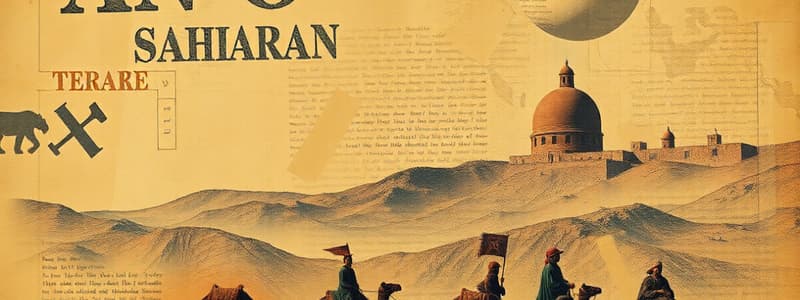Podcast
Questions and Answers
What primary geographic challenge did the trans-Saharan trade overcome to facilitate economic exchange?
What primary geographic challenge did the trans-Saharan trade overcome to facilitate economic exchange?
- Sailing across stormy seas with unpredictable weather.
- Crossing vast mountain ranges.
- Traversing a large desert with limited resources. (correct)
- Navigating dense jungle terrain.
Why were camels considered essential to the trans-Saharan trade?
Why were camels considered essential to the trans-Saharan trade?
- They were the only animals strong enough to carry trade goods across water.
- They possessed a natural immunity to all desert diseases.
- Camels could carry heavy loads and endure long periods without water. (correct)
- Camels were commonly available and inexpensive throughout Africa.
What role did the Berbers play in the trans-Saharan trade?
What role did the Berbers play in the trans-Saharan trade?
- They primarily served as guides for maritime trade routes.
- They facilitated the trade of goods across the desert as part of large caravans. (correct)
- They were the main manufacturers of trade goods like silk and textiles.
- They were responsible for protecting trade routes from pirates on the Indian Ocean.
What was a common exchange that occurred between the Berbers and West Africans?
What was a common exchange that occurred between the Berbers and West Africans?
What was a significant non-economic impact of the trans-Saharan trade on West Africa?
What was a significant non-economic impact of the trans-Saharan trade on West Africa?
How did the trans-Saharan trade routes functionally resemble maritime trade routes?
How did the trans-Saharan trade routes functionally resemble maritime trade routes?
Imagine a West African kingdom is seeking to increase its influence in both Europe and China during the height of the trans-Saharan trade. What action would best support this goal?
Imagine a West African kingdom is seeking to increase its influence in both Europe and China during the height of the trans-Saharan trade. What action would best support this goal?
A historian is studying the impact of trans-Saharan trade on the development of West African societies. Which primary source would provide the MOST direct evidence of this impact?
A historian is studying the impact of trans-Saharan trade on the development of West African societies. Which primary source would provide the MOST direct evidence of this impact?
If a new trade route emerged that bypassed the Sahara Desert by utilizing advanced maritime technology to sail around Africa, what is the MOST likely long-term economic impact on the Berber traders?
If a new trade route emerged that bypassed the Sahara Desert by utilizing advanced maritime technology to sail around Africa, what is the MOST likely long-term economic impact on the Berber traders?
Imagine you're advising a merchant in the 10th century who wants to maximize profits while minimizing risks in the trans-Saharan trade. Which strategy would be MOST effective?
Imagine you're advising a merchant in the 10th century who wants to maximize profits while minimizing risks in the trans-Saharan trade. Which strategy would be MOST effective?
Flashcards
Trans-Saharan Trade
Trans-Saharan Trade
Trade routes connecting the Saharan region to the outside world from the 9th-13th centuries.
Camels
Camels
Animals used for the Trans-Saharan trade because they could carry heavy loads and travel long distances without water.
Caravans
Caravans
Groups of traders traveling together over long distances, often with camels.
Berbers
Berbers
Signup and view all the flashcards
Salt
Salt
Signup and view all the flashcards
Gold, Ivory & Ebony
Gold, Ivory & Ebony
Signup and view all the flashcards
Islam
Islam
Signup and view all the flashcards
Ships of the desert
Ships of the desert
Signup and view all the flashcards
Arabic Language
Arabic Language
Signup and view all the flashcards
Booming Trade
Booming Trade
Signup and view all the flashcards
Study Notes
- The Trans-Saharan caravan trade was a system of extensive trade routes that connected the Saharan region to the outside world from the 9th through 13th centuries.
- The trans-Saharan caravan trade was very active, and is referred to as a sandy sea.
- Camels were called the ships of the desert.
- Camels were the animal of choice because they could carry lots of weight, go long periods without water, and move quickly.
- Merchants and their camels formed caravans, or groups of traders traveling together over long distances.
Berbers
- The Berbers were a group of Arabs from North Africa who carried trade goods across the desert.
- Berber caravans usually consisted of hundreds, if not thousands, of camels; one Arab caravan had about 12,000 camels.
- Arab caravans carried silk, salt and textiles to Africa, traded with West Africans for gold, ivory and ebony wood and traded these goods in Europe and China.
- The Arabs and their caravans succeeded in connecting Africa to the outside world.
Islam
- Arab caravans brought the faith of Islam to West Africa.
- The connection remains alive and well as many of the people of West Africa still claim allegiance to the Islamic faith.
- The African trade routes lost popularity as Europeans sailed around Africa, and as the discovery of the Americas gave the world another place to get gold.
Studying That Suits You
Use AI to generate personalized quizzes and flashcards to suit your learning preferences.
Description
Explore the extensive Trans-Saharan caravan trade routes connecting the Saharan region to the world from the 9th-13th centuries. Learn about the role of Berber caravans consisting of camels in trading goods such as silk, salt, gold and ivory between Africa, Europe and China.




